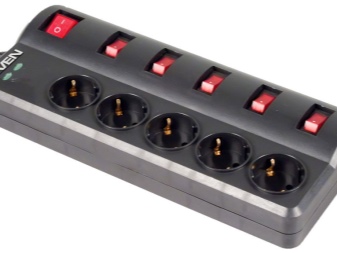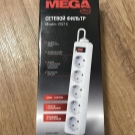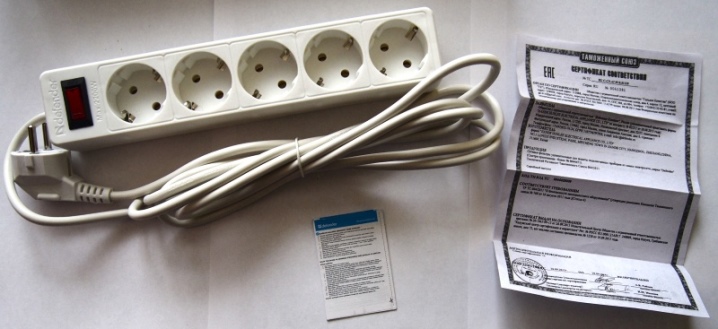Choosing a network filter

The modern age has led humanity to the fact that in every home there is now a large number of the most diverse equipment that is connected to the power supply network. Often there is a problem of lack of free sockets. In addition, in large cities and remote settlements, residents are faced with such a phenomenon as power surges, as a result of which household appliances fail. To control the situation, they purchase a reliable network device - a surge protector, which will provide an additional number of outlets for the user, and also protect the equipment from voltage surges.

What is it and what is it for?
A device called a surge protector has the main purpose of preventing short circuits in electrical devices. An electrical device in appearance may resemble an extension cord, but its device has a different principle of operation, and the protection of devices against overvoltage in the electrical network is as follows.
- The presence of a varistor - its purpose is to dissipate excess electricity that appears during a voltage surge in the network. The varistor converts electricity into heat. If the level of thermal energy turns out to be too high, then the varistor works at the limit of its capabilities and, having completed the task, burns out, while your equipment still remains intact.
- Many surge protectors have a built-in thermal cutout that can cut off voltages that exceed the permissible level. The thermal cutout is automatically triggered and protects the varistor, prolonging its performance. Thus, the surge protector does not burn out at the first power surge, but can serve for a long time.
- In addition to power surges, the surge protector also removes high-frequency noise from the power grid. To filter the interference, the device has special coil-type devices. The higher the high frequency noise rejection level of the line filter, which is measured in decibels, the better and more reliable the device.






The surge protector is a reliable assistant in the event that a short circuit occurs in the electrical network. - this happens when the electrical wire breaks, at this time the phase and zero are connected to each other without loads, and the filter is able to protect the electrical appliance from damage. As for electrical interference, it is worth noting that now all modern household equipment operates on the principle of impulse power supply, and the impulse units of the equipment also give off high-frequency interference to the power grid.




In addition, such interference can be caused by devices with a high inductive load, for example, it can be a refrigerator. High-frequency interference does not harm electrical equipment, but it has a bad effect on its operation, for example, ripples appear in the TV from such interference. To protect yourself from interference, you must use surge protectors.
How is a surge protector different from an extension cord?
More recently, it was very easy to distinguish a surge protector from an extension cord - by the presence of a power button. Extension cords did not have such a button.Today, such a distinction no longer works, since manufacturers also began to install a button for disconnecting the contact with the mains on extension cords, therefore, these devices should be distinguished only by their characteristics and technical device. An extension cord is a mobile version of an electrical outlet, some varieties are also equipped with built-in protection against overheating or short circuits. The task of the extension cord is to provide power for equipment at some distance from a regular outlet.


Electrostatic precipitators are able to provide equipment with power supply at some distance from a stationary electrical outlet, but they also protect against high-frequency impulse noise and prevent the occurrence of electrical short-circuits. The filter, in contrast to the extension cord, contains a varistor, a filtering choke to eliminate interference and a contactor, which has thermal sensitivity and protects the equipment from overvoltage.

When choosing between a surge protector and an extension cord, it is necessary to determine the purpose for which this or that device will be used. An extension cord can solve the problem of moving an electrical outlet, and a mains filter will protect the equipment from short circuits.
Comparison with a voltage regulator
In addition to the mains filter, a stabilizer is used to control the voltage, which has its own difference, and this difference is as follows.
- The stabilizer provides a constant voltage of electric current. In case of voltage surges in the network, this device increases or decreases the current transformation ratio.
- The stabilizer converts the voltage and protects the equipment from impulse and high-frequency interference.
- If the voltage level in the mains exceeds the permissible parameters, the stabilizer will be able to lower the input current value and disconnect the devices from the mains.


It is advisable to purchase a voltage stabilizer for expensive electrical equipment - a computer system, TV, refrigerator, audio equipment, etc. If we compare a surge protector and a stabilizer, then there are differences between them.
- The cost of the stabilizer is higher than that of the surge protector. If you put a stabilizer for a network where there are no sudden voltage drops, then the potential of the device will not be used, so it makes sense to use a surge protector.
- A stabilizer must not be connected to power sensitive equipment., such devices need a sinusoidal voltage supply curve, and not the stepped one that the regulator will provide. The surge protector does not affect the type of voltage supply, therefore its range of application is much wider.
- The stabilizer has a slower response speed during a voltage surge, therefore, the device will be unsuitable for computer technology, since the equipment will already be damaged by the short circuit. In this case, the network device will provide an even and continuous power supply and timely protection. For devices for which the speed of protection operation is important, you will need to choose specialized stabilizers or use an uninterruptible power supply.

It is impossible to say unequivocally which is better - a stabilizer or a network device, since the choice of such devices depends on their functionality. Each device has its own advantages and disadvantages.
Types of protection
All surge protectors are conventionally divided into types, depending on the degree of protection they provide.
- Basic protection option. The devices have a minimum protection against voltage surges in the power supply network. They are used to connect inexpensive equipment with low power consumption. The filters are a replacement for conventional surge protectors. Their cost is low, the design is the simplest, and the service life is short.


- Advanced protection option. Filters can be used for most household and office appliances, they are produced with RCDs and are presented on the market for similar products in a wide range. The cost of the devices is above average, but the price corresponds to the quality of the equipment.


- Professional protection option. The devices can extinguish any impulse network noise, so they can be used to connect any, including industrial type of equipment. Professional surge protectors are usually earthed. These are the most expensive devices, but their reliability corresponds to the funds spent on the purchase.

Power filters for various purposes are suitable for operation with a current transmission frequency of 50 Hz and protect the connected equipment from interference and short circuit situations.
Views
The variety of surge protectors is great today; it will not be difficult to choose the required model. The filter can be vertical or round, it can be used as a desktop version or hung on the wall, if desired, you can use a surge protector built into the tabletop. Advanced types of electrostatic precipitators are adjustable with remote control. The difference in the types of surge protectors makes it possible to carry out:
- USB port protection - to such a design, you can connect a device with an appropriate connector for recharging, for example, a smartphone, media player, etc.;
- possibility of separate switching on of each outlet - conventional models with a single button turn off the power of the entire surge protector, but there are advanced options where the outlet can be selected and turned on autonomously for use;
- fixing the structure of the surge protector to the wall - this can be done with the help of a special loop on the body of the device, or it can be firmly fastened using 2 fasteners located on the back of the structure.


Most modern high-quality models of the surge protector have special protective shutters in the sockets that protect the structure from dust and from children's access to electrical equipment.
Rating of the best models
The range of surge protectors today is huge, leading world manufacturers such as England, Germany, Finland, supplying quality goods, as well as unfamiliar Chinese firms sell their products in Russia. The most advanced network voltage monitoring products have fused designs, a built-in thermal cutout, and a smart remote control unit that can be used to turn the device off or on without a wire.






Filters with a timer have become common, when the power button at a certain time is activated in automatic mode. The most convenient models have a self-contained button with a switch for each outlet - as a rule, this is a rather powerful and expensive type of network device. Most of the goods found on the shelves of specialized retail chains are Russian-made. An overview of some of the top line filter models is as follows.




For 3-6 outlets
The most common option is a 3-6 outlets surge protector.
- PILOT XPro - this version has an unusual-looking ergonomic case for 6 open-type sockets. The length of the wired cable is 3 m, the filter operates under the voltage of a household electrical network of 220 V, the maximum load for it is 2.2 kW.

- APC by SCHNEIDER Electric P-43B-RS - compact surge protector with grounding at each outlet, the length of the power cord is small and is 1 m. Designed for office use when connecting work computer equipment. On the body of the structure there is a mount for wall placement. The switch is equipped with indicator lights, shutters are installed on the sockets. It can operate in a 230 V network with a maximum load of 2.3 kW, has 6 sockets.

There are filters for 4 or 5 outlets, but the most commonly used designs are with 6 sockets.
With USB port
Modern surge protectors provide protection for devices with a USB port during recharging.
- ERA USF-5ES-USB-W - the device, made in version B 0019037, is equipped with 5 sockets for connectors of the European type, each outlet is provided with a grounding. The design is provided with 2 holes in the body, which allows it to be fixed to the wall. There are 2 USB ports located near the outer sockets on the structure. The length of the electrical cable is small and is 1.5 m. The surge protector operates in a 220 V power network, with a maximum load of 2.2 kW.

- LDNIO SE-3631 - has an attractive appearance and a compact body, where 3 Euro-type sockets and 6 USB ports are located at a convenient distance from each other. Such a surge protector is designed mainly to protect equipment with appropriate connectors; here you can simultaneously recharge several modern gadgets at once. The cable length is short and amounts to 1.6 m.The device operates on a 220 V household power supply.

Most often, models equipped with a USB port have European type sockets on the case, which allows you to connect many modern devices.
Other
The line filter options are various. There is even a single-outlet filter that is used to connect, for example, a refrigerator in the kitchen - the device does not take up much space and successfully performs its tasks. Consider other options as an example.
- CROWN Micro CMPS 10. This device has a very catchy and unusual design that makes the filter attractive. The design of the device is quite wide and allows you to connect for recharging not only ordinary electrical appliances or gadgets, but also a television antenna. The filter includes 10 outlets, 2 USB ports, a telephone line protection port and a coaxial IUD to protect the TV antenna. The power cord is made for a sufficient length of 1.8 m. The surge protector operates from a 220 V household power supply with a maximum load of up to 3.68 kW.

- Bestek EU Power strip MRJ-6004 Is a small-sized multifunctional surge protector that has the ability to simultaneously connect 6 electrical appliances, and each outlet has its own autonomous switch. In addition to sockets, the device includes 4 USB ports. The length of the electric cable is 1.8 m. The device operates from a 200-250 V power grid, with a maximum electric power of up to 3.6 kW.

The selection of the surge protector model depends on the purpose of the application and the power supply conditions.
How to choose?
The best option, which combines the properties of a surge protector and a stabilizer in one device, is a UPS device with a battery, which is an uninterruptible power supply. The UPS is characterized by a smooth sine wave of the voltage drop, therefore it is used to stabilize operation for household appliances and for a computer. The choice of a surge protector for home or professional use is made after studying all the features and characteristics of the electrical network. Many modern buildings are grounded, but there are old buildings that do not have such protection, for such cases a reliable surge protector is required. Often in the same apartment, different filters are used for the TV, for the refrigerator, for home equipment.

When choosing a surge protector, you need the following.
- Determine the power of the device - calculate how many devices and with what power will be simultaneously connected to the filter, add a margin of at least 20% to the total number.
- The parameter of the maximum energy of the input pulse is important - the higher this indicator, the more reliable the network device will be.
- Determine the presence of a thermal fuse in the filter to protect the filter from overheating.
- Determine the number of outlets for connection, and if devices need to be disconnected from the network often, then it is better to choose a filter with autonomous disconnection of each outlet.
- Consider how long the electrical cable will be needed.

After defining the main parameters, you can consider the availability of additional options - timer, remote control, USB port, etc.
How to check?
It is impossible to perform a test of a surge protector before purchase, therefore it is chosen only for key characteristics. Most modern models have an operating voltage range of up to 250 V, more expensive professional options can operate up to 290 V. For the manufacture of high-quality surge protectors, conscientious manufacturers use non-ferrous metal alloys, which, when used, do not overheat and do not melt the filter housing, causing a fire. Cheap options for devices are made using ordinary metal. You can check the composition of the components if you bring the magnet to the body of the surge protector - if it is made using non-ferrous metal, then the magnet will not stick, and if cheap ferrous metals are used, the magnet will stick.

Operating tips
In order for the surge protector to serve for a long time and properly, it is recommended to follow some rules:
- when connecting devices, do not exceed the power limit of the device;
- do not include several splitters at once;
- Do not connect the surge protector to the UPS as this will cause the protection system to malfunction.

If you want to be sure of the reliability of a network device, then preference when choosing at the time of purchase should be given to trusted manufacturers with a good reputation.
For information on how to choose the right surge protector, see the next video.













The comment was sent successfully.